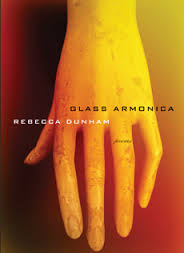
 Glass Armonica by Rebecca Dunham (Milkweed Editions, 2013)
Glass Armonica by Rebecca Dunham (Milkweed Editions, 2013)
If you’ve ever run a wet finger around the rim of a wine glass you know the eerie sound it creates, like the voice of a ghost, piercing, haunting, and beautiful. Change the amount of liquid in the glass and you can draw out a different pitch. That’s the basic concept of a glass armonica, also known as a glass harmonica or bowl organ (played here by Thomas Bloch). The poems in Rebecca Dunham’s third collection of poems are as haunting as the sound of the instrument the collection is named for.
Glass Armonica is about bodies, particularly women’s bodies, and about how they’re touched—often without consent. It’s about how sometimes touch isn’t physical; sometimes a look is a touch, sometimes a word. The title section of the book, a crown of sonnets, takes touch of women as its central theme. The first section sets the scene:
List of all I can recall: his hair,
red and curly; I was ten; how I slept
in the top bunk, in July heat;
his first name: Richard;
damp-swollen smell of pine
and unwashed clothes in the girls’
cabin; waking to his hand[.]
The remaining 13 sonnets use voices of historical “hysterics” who are touched or almost touched by their male physicians. “I never quite touch,” Franz Mesmer says in one poem:
[…] I urge her to put
aside this hysteria and play her
like a glass amonica, pull tone upon
tone from her, for hours.
These doctors, and Dunham herself, are in the business of trying to “unfasten, to unbed trauma / from memory’s sediment.” What Dunham sees—and the doctors don’t—is that small pains become large hurts until the original wound is buried by the “sediment” of new traumas inflicted by the act of “unbedding.”
Dunham’s diction can be a precision instrument, a scalpel so sharp you hardly notice the cut until you see blood. Perhaps you never notice it, like the alert speaker in “Hemispherectomy” who asks, “How can I survive?” as a doctor,
[…] drills, stippling
a semi-circle across my shorn
scalp and peels the dura free
in flaps.
The language is precise, employed to maximize effect and minimize impact on the page. Dunham leaves much white space, which acts as a screen on which the mind projects her images. Dunham’s language can be fragmented as well to make more sharp edges that might cut even the most careful reader. Perhaps the most fragmented poem is “Is Pear :: Is” which includes this passage:
my :: hymen my
mons :: no
stiletto :: let slit
wheal awl :: hew all
predator :: or parade
Assonance and alliteration run together, turning words inside out to make familiar words dangerous.
Dangerous words are what the speakers in Dunham’s poems need. Throughout the collection, words are hard to come by. They are “untranslatable” or won’t come because “all of our jaws / were locked” or because the speaker is “closed like / a knife” (those sharp edges, again). Ultimately, though, the speakers do want to speak and be heard. “Unplait me” asks the final poem, “To Winter:”
I want this for us:
both the re-leaf and release of furrowed brow and chest.
To feel the blossom of a lover’s breath.
To feel you untie the knotted throat.
Since to be “untied” is the final request, it’s important that we listen and remember the stories these poems recall. It’s important to remember the history of touch and how it relates to women’s bodies, and it’s important to listen to the women whose bodies have been touched. Dunham’s poems pierce the psyche and unsettle the reader, but they have to if the cycle of nonconsensual touch is to be broken. Her poems are, like a glass armonica, ghostly and melancholy and lovely, and will pierce to the reader’s core.
What other poets use discomfort and unsettling language to shape the way we read a poem?





